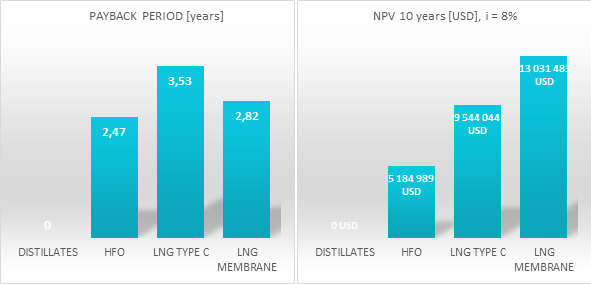Deltamarin together with Gaztransport & Technigaz (GTT), an engineering company involved in membrane containment systems for transport and storage of LNG, has studied the use of membrane-type tanks on cargo and passenger vessels.

For quite some time now, Liquefied Natural Gas (LNG) has been an established fuel alternative for short sea shipping routes and also acts as a complementary fuel for longer routes.
Deltamarin’s references include various vessels with LNG capabilities, and usually a C-type tank is the common place solution for fuel storage. However, when the desired range, autonomy or ship size increase, other tank technologies may become more viable for LNG fuel storage. Among them, a well-known and experienced technology is the membrane-type tank by GTT. In close cooperation with GTT, Deltamarin has created a unique portfolio of cargo and passenger vessels to save valuable cargo space compared to classic cylindrical-type LNG tank solutions and to enable the use of LNG for long ocean voyages.

The portfolio includes a container vessel, a pure car and truck carrier (PCTC) and a cruise ship.
During the development project, each of the vessels was equipped with a modularised GTT membrane tank type solution, which can be adjusted in size from 1,000 to 5,000 m³, depending on the case vessel. Either one or multiple tanks can be integrated into the vessel. The final fuel capacity is a trade-off between desired cargo capacity and bunkering intervals.
As an example, a container ship case vessel with a 2,500 m³ tank offers an autonomy time of 22 days or can reach 10,000 nautical miles. These figures ensure that most intra-Asian, intra-European or intra-American trade loops can be sailed in just one bunkering operation. Naturally, other sizes offering the same volume efficiency but less cargo space sacrificed are available, for example 1,000 m³, 1,500 m³ or 2,000 m³. Similar scalable solutions exist for the PCTC and the cruise ship.

On average, calculations during the development project showed that only approximately 60% of the LNG capacity provided by membrane technology could be accommodated in the same space, when using an optimised bi-lobe C-type tank solution. For large fuel capacities, therefore, the membrane solution is clearly the most feasible LNG fuel tank solution.
Does this all make sense financially? According to Deltamarin’s calculations, in many cases it does. A financial scenario calculation was carried out with the following input parameters in which distillates (MGO) has been defined as a reference level:
| Case vessel: | 8,000 CEU PCTC |
| Required LNG endurance: | 15,000 nm |
| Operation profile: | 5 trips/year (Asia – Europe route) |
| Other alternatives: | Use of MGO, HFO + scrubber, LNG Type-C tank |
| Fuel price scenario: |
MGO 600 $/tonne HFO 400 $/tonne LNG 350 $/tonne |
| Price for CEU slot per voyage: | 800 $ |

As the figures indicate, in this case the LNG membrane tank solution pays itself back in less than 3 years compared to the reference level, whereas HFO with the scrubber option offers slightly shorter payback time.
From a Net Percent Value (NPV) point of view, the LNG membrane solution offers the highest value of all options over the ten-year period. This is due to the savings made by both, in LNG fuel price and efficient use of hull volume for LNG fuel tanks. Compared to Type-C tank solution, a significant amount of valuable cargo space inside the hull can be saved. The HFO option also has moderate fuel costs but is penalised because of the extra power and sludge handling required by the scrubber operation. With the fuel price scenario used, operating with MGO almost doubles the operating cost over 10 years compared to LNG options.
It can thus be said that, from a financial point of view too, LNG as fuel and membrane technology as a fuel storage solution are definitely feasible for various projects. However, it must be noted that the analysis is very sensitive to fuel prices and fuel tank capacities.
"In addition to its existing vast experience in the conventional C-type tank solution, Deltamarin is now able to provide an extensive solution for LNG as fuel with the GTT Membrane tank. We work with all of the leading solution providers of tank technology and our expertise covers both short and long ocean operations with LNG." - Deltamarin
Source: Deltamarin